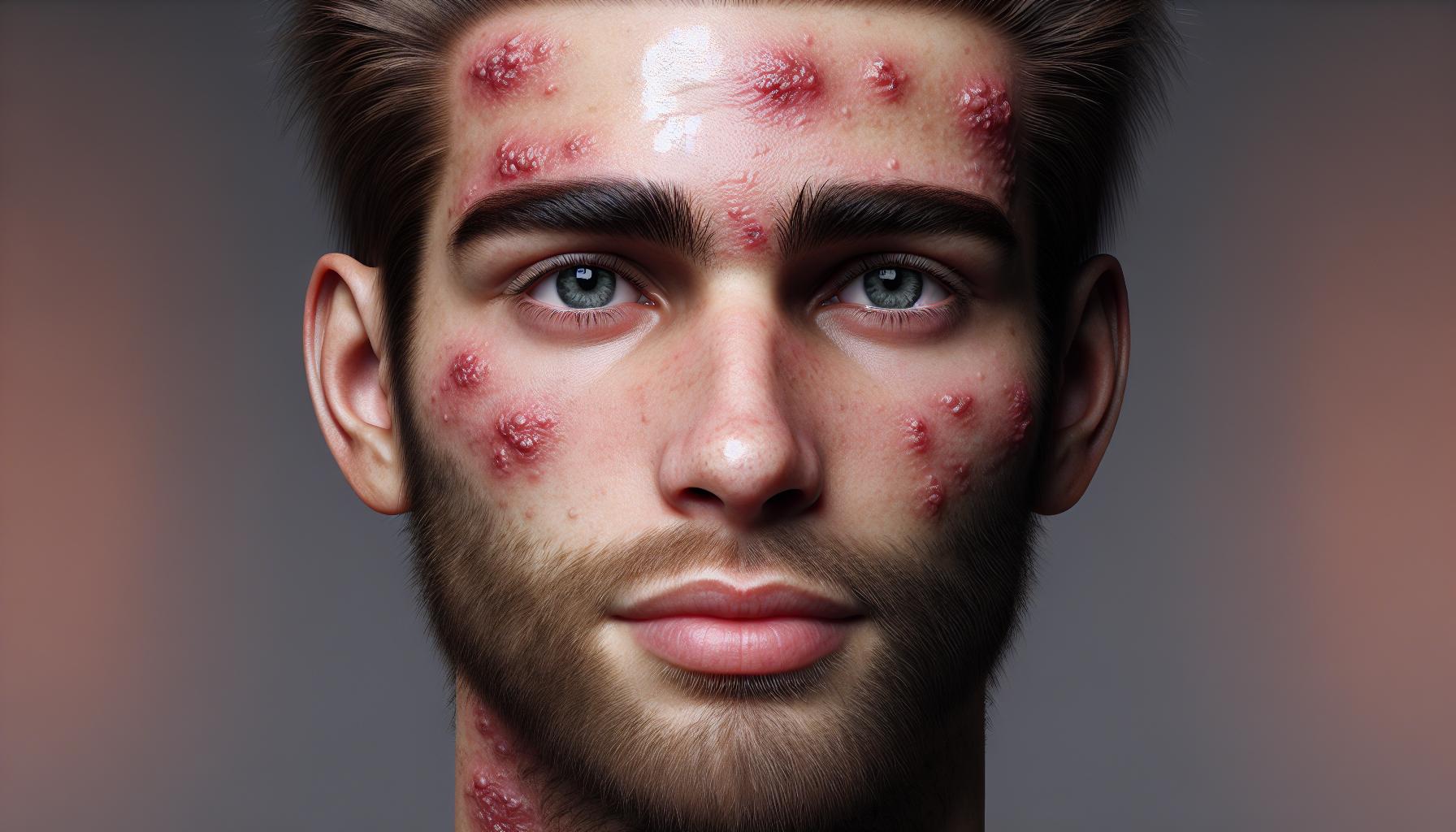Dealing with those pesky red patches and stubborn flakes on your face? You might be facing seborrheic dermatitis, a common skin condition that affects millions worldwide. While it may sound like a tongue-twister medical term, it’s essentially your skin throwing a tiny tantrum.
This chronic inflammatory condition loves to make itself at home in the oiliest parts of your face, particularly around the nose, eyebrows and scalp. Think of it as your skin’s unwanted house guest that keeps overstaying its welcome. While it’s not dangerous or contagious, it can certainly be frustrating to manage – especially when you’re trying to look your best for that important meeting or date night.
Face:1q2nm0was2o= Seborrheic Dermatitis
Seborrheic dermatitis forms distinct patterns on facial areas with high concentrations of oil-producing glands. The condition manifests in key facial zones:
- T-zone region covering the forehead nose center
- Eyebrows plus surrounding skin patches
- Nasolabial folds extending from nose to mouth
- External ear canal plus behind-ear areas
- Beard region in individuals with facial hair
Facial seborrheic dermatitis displays several identifiable symptoms:
- Red scaly patches with defined borders
- Greasy yellow flakes adhering to skin
- Mild itching sensations in affected zones
- Burning feelings during flare-ups
- Skin redness ranging from pink to deep red
Specific factors trigger or worsen facial flare-ups:
- Stress periods increasing skin inflammation
- Cold dry weather causing skin barrier disruption
- Hormonal changes affecting oil production
- Harsh skincare products irritating sensitive areas
- Increased yeast growth in oily skin regions
| Affected Area | Occurrence Rate | Common Symptoms |
|---|---|---|
| T-zone | 87% | Redness flaking |
| Eyebrows | 76% | Scale formation |
| Nasolabial folds | 65% | Greasy patches |
| Ear area | 45% | Itching redness |
| Beard region | 38% | Flaking irritation |
The presence of Malassezia yeast contributes to inflammation in oil-rich facial areas. This microscopic organism feeds on skin oils creating an inflammatory response in susceptible individuals.
Common Symptoms and Affected Areas

Seborrheic dermatitis manifests in distinct patterns across facial regions with high concentrations of sebaceous glands. The condition creates visible symptoms that range from mild to severe depending on individual factors.
Facial Distribution Patterns
Seborrheic dermatitis predominantly appears in the T-zone area, including the forehead, nose bridge, and chin. The condition targets specific facial zones:
- Nasolabial folds: Redness extends from the sides of the nose to the mouth corners
- Eyebrows: Flaking occurs along the brow line, often extending to the forehead
- Hairline: Patches develop where facial skin meets the scalp
- Beard area: Men experience flaking in facial hair regions
- External ear canal: Scaling appears behind and inside the ears
Redness and Scaling
Seborrheic dermatitis presents distinctive visual symptoms across affected areas:
- Red patches appear with defined borders on affected skin
- Yellowish-white scales form in oily areas
- Greasy flakes stick to the skin surface
- Skin texture becomes rough or bumpy
- Color variations range from light pink to deep red
- Mild to moderate itching in affected zones
- Burning sensation during active flares
- Skin tightness after washing
- Increased sensitivity to skincare products
- Temporary pain when touching inflamed areas
Causes and Risk Factors

Seborrheic dermatitis develops from a complex interaction between multiple biological factors contributing to skin inflammation. The condition stems from an overactive immune response combined with specific environmental triggers affecting susceptible individuals.
Fungal Overgrowth
Malassezia yeasts play a central role in triggering seborrheic dermatitis symptoms on facial areas. These naturally occurring fungi metabolize sebum into oleic acid which penetrates skin barriers causing inflammation in 3-5% of adults. Research indicates elevated Malassezia levels correlate with symptom severity particularly in oil-rich zones like the T-zone nasolabial folds. The fungi thrive in warm humid conditions leading to increased colonization during summer months sweating episodes.
- Cold temperatures reduce skin barrier function increasing moisture loss
- Stress hormones boost oil production creating optimal fungal conditions
- UV exposure alters immune responses in affected skin areas
- Indoor heating systems decrease ambient humidity affecting skin hydration
- Harsh cleansers disrupt natural skin pH balance increasing sensitivity
- Seasonal changes modify skin microbiome composition
- Certain medications alter sebum production patterns
- Medical conditions affecting immunity worsen symptoms
- Hormonal fluctuations influence oil gland activity
- Diet changes impact inflammatory responses systemically
Treatment Options

Effective management of facial seborrheic dermatitis combines targeted medical treatments with lifestyle modifications. Treatment approaches focus on controlling inflammation reducing Malassezia yeast populations addressing symptoms.
Medical Treatments
Antifungal medications form the cornerstone of seborrheic dermatitis treatment. Ketoconazole cream (1-2%) reduces Malassezia populations when applied daily for 2-4 weeks. Hydrocortisone (1%) cream provides rapid relief from redness inflammation during acute flares. Additional prescription options include:
- Tacrolimus ointment (0.1%) for sensitive areas like eyelids nasolabial folds
- Ciclopirox cream reduces both fungal growth inflammation
- Lithium gluconate (8%) targets persistent patches resistant to other treatments
- Metronidazole cream (0.75%) controls inflammation in severe cases
- Aloe vera gel reduces inflammation redness with twice-daily application
- Raw honey masks (15 minutes) decrease Malassezia counts moisturize skin
- Green tea compresses provide antioxidant anti-inflammatory benefits
- Apple cider vinegar diluted 1:4 with water helps restore skin pH balance
- Coconut oil contains caprylic acid which inhibits fungal growth
Prevention and Skincare Tips
Managing seborrheic dermatitis requires a consistent skincare approach combined with specific lifestyle adjustments. These preventive strategies help minimize flare-ups and maintain skin health.
Daily Face Care Routine
A gentle cleansing routine forms the foundation of seborrheic dermatitis management. Washing the face twice daily with a pH-balanced cleanser removes excess oil without stripping the skin barrier. Non-comedogenic moisturizers applied to damp skin lock in hydration. Anti-inflammatory ingredients like zinc pyrithione niacinamide or green tea extract reduce redness. Exfoliation with salicylic acid products occurs 1-2 times weekly to prevent scale buildup. Mineral-based sunscreens with SPF 30+ protect sensitive skin from UV damage. Products containing fragrance dyes alcohol or harsh sulfates stay off the skincare shelf as these trigger inflammation.
Lifestyle Modifications
Regular exercise promotes healthy blood circulation to facial skin tissue. A balanced diet rich in omega-3 fatty acids zinc vitamin D supports skin barrier function. Stress management techniques like meditation deep breathing or yoga reduce cortisol levels linked to flare-ups. Using a humidifier maintains 40-50% indoor humidity preventing skin dehydration. Cotton pillowcases changed weekly minimize bacterial growth. Keeping hair products away from the face reduces irritation. Recording triggers in a symptom diary tracks patterns enabling targeted prevention. Temperature extremes harsh winds direct heat sources increase symptoms requiring protective measures.
Comprehensive Approach
Managing seborrheic dermatitis requires patience dedication and a comprehensive approach. By understanding triggers implementing proper skincare routines and making lifestyle adjustments patients can effectively control their symptoms and minimize flare-ups.
While there’s no permanent cure the condition can be successfully managed with the right combination of medical treatments and self-care practices. Anyone experiencing persistent symptoms should consult a dermatologist to develop a personalized treatment plan that addresses their specific needs and skin concerns.
Remember that finding the right balance may take time but with consistent care and attention most people can achieve clearer healthier-looking skin.



